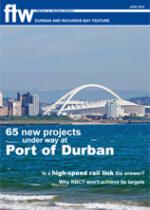After the best part of R4 billion
has been spent on widening and
deepening the entrance channel
to Durban harbour, you may be excused
for thinking that Transnet National
Ports Authority Port of Durban would
consider taking a break while enjoying
the luxury (and reward) of larger ships
coming into the bay.
Not so! It turns out that TNPA has
65 other projects either under way or
on the books at the Port of Durban.
Some are quite small and involve basic
maintenance while others are fairly
sizeable and run into tens of millions
of rand. Just to list these would take
more space than is available but some
of them, such as the reclamation and
refurbishment of Island View 6, which
was completed in May this year, are
quite significant and bring added
advantage to port users.
Even the entrance channel project
is not quite complete. South Africa’s
east coast experiences a phenomenon
that is not unique and occurs in many
other places across the world. Inshore
currents cause sand to be moved in a
north-easterly direction along the South
African east coast. This is part of the
littoral drift and it is this sand that helps
form the infamous sandbars that have
historically barred the entrances to ports
such as Durban, Richards Bay and East
London. Even the purely man-made
harbours like Port Elizabeth and Ngqura
are not immune and require preventative
measures.
If left unattended the sand would
eventually accumulate across the
harbour entrances and would block each
port except to shallow draft vessels.
Transnet engineers originally intended
to introduce a sand bypass system
that would automatically transfer sand
accumulating on the south side of the
Durban entrance over to the north
side, where a series of pipes would
automatically distribute the beach
sand along Durban’s Golden Mile –
actually a distance of about three miles.
However, a pilot system installed at the
new port of Ngqura revealed a number
of unexpected problems, not the least of which was that the venturi pump system
on which it is based attracted not only
sea sand but all sorts of other debris
including rocks and small stones which
rapidly clogged the system.
The decision therefore was taken
to revert to the tried and tested form
of control using dredgers that would
regularly clear the accumulation of sand
from the south side of the entrance.
To this end Transnet has placed an
order for a new dredger with a Dutch
shipbuilder and this vessel, already
named ‘Isandlwana’, is expected to
enter service at Durban before the end
of 2010.
However, the municipality was not
anticipating having to build a new
pumping station on the North Pier
and this requirement is now holding
up final completion of the North Pier,
as a permanent connection point will
have to be built for the dredger for the
transfer of sand dredged from the south
side of the channel and placed into the
municipal pump station on the North
Pier. Construction of these facilities is
expected to commence sometime later
this year.
Another major project being pursued
is that of deepening some of the berths
at the container terminal to accept
fully laden ships with up to 8 000 or 9
000 TEU capacity. The entrance and
access channels in Durban harbour now
have a low water depth of 16.5 metres
but alongside the berths the deepest
facility remains at 12.5 metres. Most
of the geophysical surveys and models
for rebuilding the container quays
have been completed and the project
awaits the go-ahead from the Transnet
main board, but following the recent
economic downturn any real sense
of urgency has been lacking in such
decision making.
In any event, before any deepening
of the berths can take place, an
environmental impact assessment (EIA)
will have to be conducted, and this is
likely to attract the strong attention of
environmentalist groups and those that
are concerned with the steady loss of
water area in Durban Bay.
Port management recently revealed
that the models being looked at include
the reclaiming of water space of up to
30 metres from the existing quays. If
this formula is followed along the length
of all eight container berths the water
area of Durban Bay would become
considerably reduced.
Yet without deepening the container
berths, the R4 billion project to deepen
and widen the entrance channel will
inevitably lead to question marks over
why it was necessary in the first place.
At the risk of speaking after the event,
one might start hearing questions as
to why wasn’t the berth deepening
tackled in conjunction with the harbour
widening project.
Much the same challenge lies
ahead should Transnet proceed with
yet another pending project, that of
modernising and rebuilding the historic
Maydon Wharf area. As a longer- term
project Transnet wants to deepen these
berths to an average of 14.5m alongside
to provide access for larger bulk and
breakbulk vessels to what is rapidly
becoming Durban’s last remaining
breakbulk terminal area – a section of
the port that also handles a considerable
quantity of bulk cargo. Considering
that the port handled approximately 5
million tonnes of breakbulk cargo in
2009, forming part of the 37 million
tonnes of bulk and breakbulk (including
liquid bulk) handled at Durban, the
importance of retaining some facility for
this type of cargo is self evident.
Another 65 projects under way at Port of Durban
09 Jul 2010 - by Terry Hutson
0 Comments
Durban 2010

09 Jul 2010
09 Jul 2010
09 Jul 2010
09 Jul 2010
09 Jul 2010
09 Jul 2010
09 Jul 2010
09 Jul 2010
09 Jul 2010
09 Jul 2010
09 Jul 2010
Border Beat
Featured Jobs
New
New
